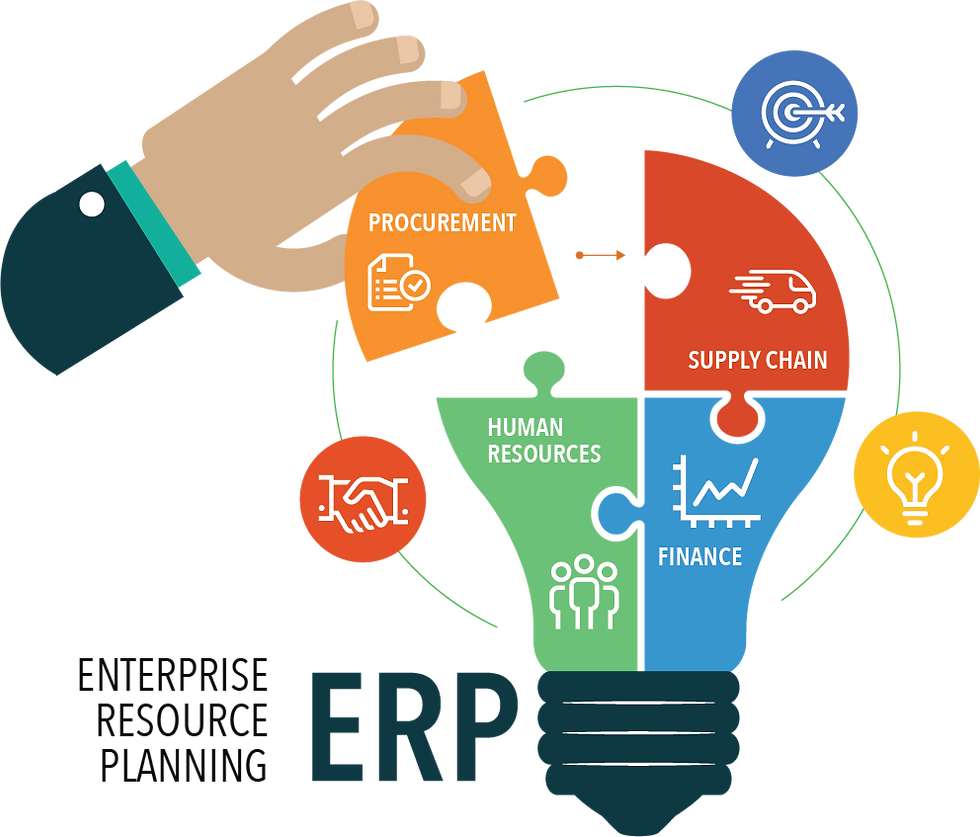Enhancing Educational Efficiency: The Role of ERP Software
- solutionscakiweb
- Mar 19, 2024
- 3 min read
In the fast-paced world of education, institutions are continually seeking ways to streamline processes, enhance productivity, and improve overall efficiency. Enter Enterprise Resource Planning (ERP) software – a powerful tool that has revolutionized operations across various industries, including education. By integrating disparate systems and automating key processes, ERP software has become a cornerstone for educational institutions striving to meet the demands of modern education effectively.
Understanding ERP Software in Education
ERP software essentially acts as a central nervous system for educational institutions, connecting various departments and functions under one unified platform. Traditionally, educational institutions relied on a patchwork of systems to manage different aspects of their operations, including student information, finances, human resources, and facilities. However, this fragmented approach often led to inefficiencies, data silos, and increased administrative overhead.
ERP software consolidates these disparate systems into a single, integrated platform, providing administrators, faculty, staff, and students with a unified view of critical information. From admissions and enrollment to academic planning, financial management, and alumni relations, ERP software streamlines processes, enhances collaboration and enables data-driven decision-making.

Key Features and Functionality
Modern ERP solutions designed for educational institutions offer a comprehensive suite of features tailored to the unique needs of the sector. Some key functionalities include:
1. Student Information Management: ERP software allows institutions to manage student data throughout the entire student lifecycle, from admissions and enrollment to graduation and beyond. It facilitates the tracking of academic progress, course registrations, grades, attendance records, and disciplinary actions.
2. Financial Management: With robust financial modules, ERP software enables efficient budgeting, accounting, invoicing, and procurement processes. Institutions can track revenues and expenses, manage grants and scholarships, and generate financial reports with ease.
3. Human Resources: ERP systems streamline HR processes, including recruitment, payroll management, performance evaluation, and employee development. Centralized employee databases ensure accurate record-keeping and compliance with regulatory requirements.
4. Academic Planning and Course Management: Educational institutions can utilize ERP software to create and manage academic programs, course schedules, and curriculum requirements. Faculty members can access course materials, submit grades, and communicate with students through the platform.
5. Analytics and Reporting: ERP software provides powerful analytics tools that enable institutions to gain insights into various aspects of their operations. From student performance trends to financial forecasts, customizable reports and dashboards empower stakeholders to make informed decisions.
Benefits of ERP Software in Education
The adoption of ERP software offers numerous benefits for educational institutions, including:
1.Improved Efficiency: By automating routine tasks and eliminating manual processes, ERP software reduces administrative burdens and frees up staff time for more value-added activities.
2. Enhanced Collaboration: ERP systems facilitate seamless communication and collaboration among different departments, faculty members, and students. Real-time access to information promotes transparency and teamwork across the institution.
3. Data Integrity and Security: With centralized data management, ERP software enhances data integrity and security. Role-based access controls ensure that sensitive information is only accessible to authorized users, reducing the risk of data breaches and compliance violations.
4. Better Decision-Making: ERP software provides administrators with timely and accurate insights, enabling data-driven decision-making. Whether it's optimizing resource allocation or identifying areas for improvement, actionable analytics empower institutions to stay agile and responsive to change.
5. Enhanced Student Experience: By streamlining administrative processes and improving service delivery, ERP software contributes to a better overall student experience. From simplified registration procedures to personalized academic support, students benefit from a more efficient and responsive educational environment.
Implementation Considerations
While the benefits of ERP software in education are compelling, successful implementation requires careful planning and execution. Some key considerations include:
1. Needs Assessment: Conduct a comprehensive assessment of the institution's requirements, processes, and workflows to identify the features and functionalities required from an ERP solution.
2. Vendor Selection: Evaluate ERP vendors based on factors such as industry experience, product functionality, scalability, support services, and total cost of ownership. Engage stakeholders from across the institution in the selection process to ensure alignment with organizational goals.
3. Customization and Integration: Work closely with the chosen vendor to customize the ERP solution to meet the institution's specific needs. Ensure seamless integration with existing systems and data migration processes to minimize disruption during implementation.
4. Training and Change Management: Provide comprehensive training and support to users at all levels of the organization to facilitate the smooth adoption of the new ERP system. Implement change management strategies to address any resistance to change and promote a culture of continuous improvement.
5. Ongoing Evaluation and Optimization: Continuously monitor the performance and effectiveness of the ERP system, soliciting feedback from users and stakeholders. Identify opportunities for optimization and enhancements to maximize the return on investment over time.
Conclusion
In an era of increasing competition and complexity, educational institutions must leverage technology to enhance efficiency, improve services, and drive student success. ERP software offers a holistic solution for streamlining operations, integrating data, and empowering informed decision-making across the institution. By embracing ERP technology, educational institutions can position themselves for long-term success in an ever-evolving landscape of education. Learn more



Comments